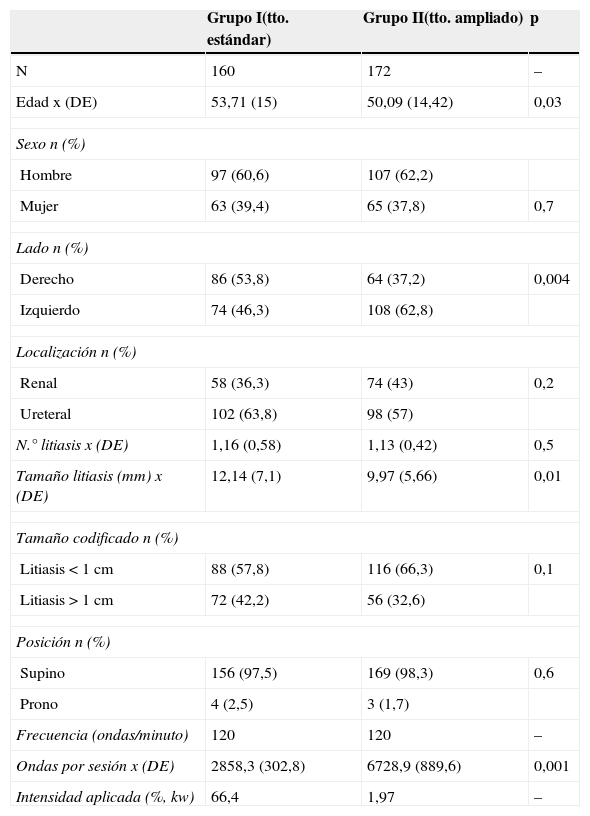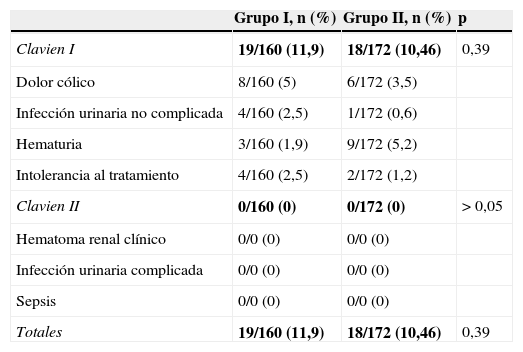Evaluar la seguridad del incremento del número de ondas por sesión en el tratamiento de la litiasis urinaria mediante litotricia extracorpórea.
Material y métodosEstudio prospectivo, comparativo, no aleatorizado, de grupos paralelos de pacientes con litiasis reno-ureteral e indicación de litotricia extracorpórea incluidos consecutivamente entre 2009 y 2010. Se comparó un grupo i (160 pacientes) tratado programadamente con un número medio de ondas/sesión estándar (2858,3±302,8) y un litotriptor Dornier Lithotripter U/15/50, frente a un grupo ii (172 pacientes) tratado con un número medio de ondas/sesión ampliado (6728,9±889,6) y un litotriptor Siemens Modularis. Las variables analizadas fueron edad, sexo, localización, tamaño de la litiasis, número de ondas/sesión y totales hasta la resolución, tasa libre de litiasis (TLL) y tasa de complicaciones (clasificación Clavien-Dindo). Para el análisis estadístico fueron empleados la «t» de Student y la Chi cuadrado.
ResultadosLa tasa de complicaciones totales fue 11,9% para el grupo i y 10,46% para el grupo ii (p=0,39). Todas ellas fueron complicaciones menores grado i (Clavien-Dindo). La más frecuente en el grupo i fue el dolor cólico y en el grupo ii la hematuria, con tasa de intolerancia al tratamiento similar (p>0,05). El número de ondas totales necesarias fue inferior en el grupo ii respecto al grupo i (p=0,001), con TLL del 96,5% y 71,5% respectivamente (p=0,001).
ConclusiónEl tratamiento con un número ampliado de ondas por sesión en litotricia extracorpórea no implica mayor tasa de complicaciones ni mayor severidad de las mismas. Sin embargo, podría aumentar la efectividad global del tratamiento.
To assess the safety of increasing the number of waves per session in the treatment of urolithiasis using extracorporeal lithotripsy.
Material and methodsProspective, comparative, nonrandomized parallel study of patients with renoureteral lithiasis and an indication for extracorporeal lithotripsy who were consecutively enrolled between 2009 and 2010. We compared group I (160 patients) treated on schedule with a standard number of waves/session (mean 2858,3±302,8) using a Dornier lithotripter U/15/50 against group II (172 patients) treated with an expanded number of waves/session (mean, 6728,9±889,6) using a Siemens Modularis lithotripter. The study variables were age, sex, location, stone size, number of waves/session and total number of waves to resolution, stone-free rate (SFR) and rate of complications (Clavien-Dindo classification). Student's t-test and the chi-squared test were employed for the statistical analysis.
ResultsThe total rate of complications was 11.9% and 10.46% for groups I and II, respectively (P=.39). All complications were minor (Clavien-Dindo grade I). The most common complications were colic pain and hematuria in groups I and II, respectively, with a similar treatment intolerance rate (P>.05). The total number of waves necessary was lower in group II than in group I (P=.001), with SFRs of 96.5% and 71.5%, respectively (P=.001).
ConclusionTreatment with an expanded number of waves per session in extracorporeal lithotripsy does not increase the rate of complications or their severity. However, it could increase the overall effectiveness of the treatment.
Artículo
Comprando el artículo el PDF del mismo podrá ser descargado
Precio 19,34 €
Comprar ahora











